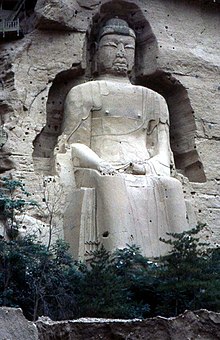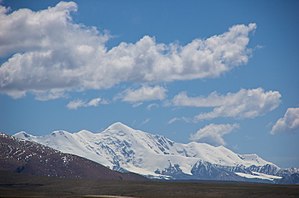|
Mario Biondi (writer)
 Mario Biondi (born 17 May 1939) is an Italian writer, poet, literary critic, journalist and translator. His reputation is mainly due to the novel Gli occhi di una donna, which earned him the important Italian award Premio Campiello in 1985.[1] He has a keen interest in Central Asia and Tibetan history and culture, and in recent years has travelled all of the Silk Road through Turkey, Iran, Uzbekistan, Kyrgyzstan, Pakistan and many provinces of China, among which Gansu, Shaanxi, Sichuan, Qinghai and obviously Xizang (Tibet). BiographyBorn in Milan and grown up near Lake Como, he graduated from Bocconi University and then worked for sixteen years in publishing (Einaudi, Sansoni, Longanesi), as Chief Press Officer before becoming a freelance author. He has been constantly active in Anglo-American narrative, of which he is also a translator and reviewer for several dailies, weeklies and monthlies. He was a professional novelist for more than twenty years, and a publicist for more than thirty. In 1973 he published a small collection of poems, Per rompere qualcosa, followed by other poems published on various literary publications or anthologies (Il Verri, Altri termini, Pianura etc.). He has also published fourteen novels and, more recently, three books of travel memories (see detailed lists below). Trivia: In the very first youth he also wore the Italian blue jersey of the junior and university teams of athletics, being included in the first prospective team for the Olympic Games in Rome, 1960, where unfortunately he could not participate due to injury. In 1994 he was awarded the Literary Prize of CONI, Comitato Olimpico Nazionale Italiano.  TravelsBiondi has begun his travels in 1968, and in 2003 he has collected his memories in his first book of travels Güle Gule. Parti con un sorriso. 35 years of voyages from New York City to Iran, through Algeria, Albania, Syria, Jordan, Turkey, Egypt. In 2004 he realized that he had unknowingly travelled most of the Silk Road, so he completed the route crossing Turkmenistan, Uzbekistan and Kyrgyzstan, reaching China at Kashgar through the Tien Shan (Mountains of Heaven) and from there crossing the Taklamakan Desert to Turpan (Caves of the Thousand Buddhas, Bezeklik). And in 2005 he collected his new memories in his second book of travels, Strada bianca per i Monti del Cielo. Between 2005 and 2007, Biondi has also completed "philologically" the Silk Road to its eastern end, represented by the ancient Chinese capitals Xi'an and Luoyang, proceeding from there to Beijing, Shanghai and Lhasa (with the famous Qingzang Railway from Xining, Qinghai). But above all visiting, in addition to Xizang (Tibet), large areas of other Tibetan Autonomous Regions in Gansu (the monasteries of the Gelugpas (Yellow Hats) in Labrang and Langmu-Si, the famous Buddha caves of Bingling-Si on the Yellow River), in Qinghai (Gelugpa complex of Kumbum, the birthplace of Tsongkhapa, monasteries of Rebkong/Tongren etc.) and in Sichuan (Great Buddha of Leshan and Mount Emei).  From these complex experiences was born in 2008 his third book of travels, Con il Buddha di Alessando Magno, long and passionate journey along the paths of the Art of Gandhara, that's to say the syncretism of the preaching of Buddha and the Hellenistic culture brought by Alexander to the Indus. A syncretism that has extended its influence to the Far East. In 2008, still in China, he has visited Ningxia, the autonomous province of the Muslim Hui, but especially, again, Qinghai, divided in the two large territories of Amdo and part of Kham (Yushu-Jyekundo), respectively inhabited by Tibetans Amdowas and Khampas. In 2009 he has continued the exploration of said territories, reaching in 2010 Mount Kailash, Lake Manasarovar and the remains of the ancient Kingdom of Guge, in Western Tibet. From there Biondi's travels continued to some Holy Festivals of Bhutan (Tsechu and Drupchhoe) and Nepal (Indra Jatra). WorksPoetry
Novels
Books of travels
TranslationsHe has translated 71 works mostly by American and English authors, including Bernard Malamud, John Updike, Edith Wharton, Anne Tyler, Peter Carey and Nobels Isaac Bashevis Singer, William Golding, Wole Soyinka and Orhan Pamuk (from the American edition of Kara Kitab - The Black Book as expressly requested by Pamuk to his first Italian publisher, Frassinelli). Activity in InternetMario Biondi has always had a keen interest in technology and its future expectations, as evidenced by the novels Una porta di luce (1998) and Codice Ombra (1999). Logical consequence, his interest in the Internet. Connected to a network from mid-1994, in April 1995 he created his Web site, first Italian writer to do so and perhaps also in Europe (they were still very few even in the USA). A site of service, which apart from providing information about the writer and his work - including the possibility of downloading narratives and critics -, offers some databases for the analysis of text in a variety of classics: Aeneid (in Latin), Bible, The Divine Comedy, Jerusalem Delivered, Orlando Furioso, The Betrothed (all in Italian). Using his knowledge of the world of Opera, Biondi has also created and posted on his site a powerful (and very used) Database of Opera. Photography: a hobbyA semi-professional hobby, strictly connected to the passion for travel that has always animated Biondi, who has posted on the Net many more than 5000 photos taken since 1968 in Italy - Algeria - Turkey - United States - Cuba - Syria - Yugoslavia - Albania - Iran - Uzbekistan - Kyrgyzstan - Pakistan - China - Nepal - Bhutan, freely visible in the proper spaces on his Web Site. Opera: a passionBiondi has always cultivated a deep interest in Opera, and over the years has accumulated thousands of recordings, creating a simple but very informed Database of Opera with data about more than 1700 titles of operas by some 600 composers in more than 5000 recordings. (Who has directed, who played, who has sung (and with whom), when, where, how ... The Database of Opera, searchable via a simple form, is freely accessible through the specific page of his Web Site. References
Bibliography
External linksWikimedia Commons has media related to Mario Biondi (writer).
|